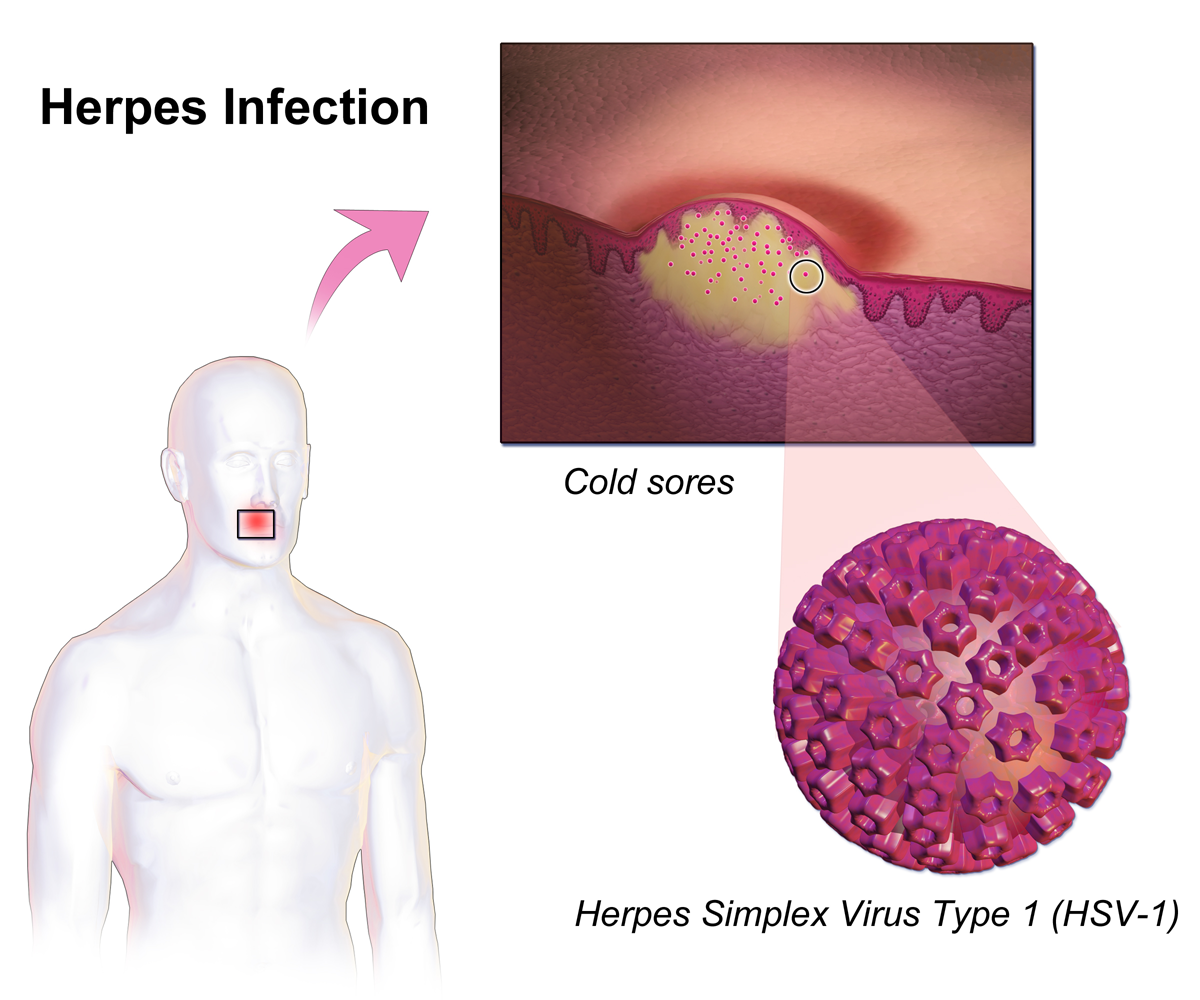|
Herpes Simplex Virus
Herpes simplex virus 1 and 2 (HSV-1 and HSV-2) are two members of the Herpesviridae#Human herpesvirus types, human ''Herpesviridae'' family, a set of viruses that produce Viral disease, viral infections in the majority of humans. Both HSV-1 and HSV-2 are very common and Infectious disease, contagious. They can be spread when an infected person begins viral shedding, shedding the virus. As of 2016, about 67% of the world population under the age of 50 had HSV-1. In the United States, about 47.8% and 11.9% are estimated to have HSV-1 and HSV-2, respectively, though actual prevalence may be much higher. Because it can be transmitted through any intimate contact, it is one of the most common sexually transmitted infections. Symptoms Many of those who are infected never develop symptoms. Symptoms, when they occur, may include watery blisters in the Human skin, skin of any location of the body, or in mucous membranes of the mouth, lips, nose, genitals, or eyes (herpes simplex ker ... [...More Info...] [...Related Items...] OR: [Wikipedia] [Google] [Baidu] |
Transmission Electron Microscopy
Transmission electron microscopy (TEM) is a microscopy technique in which a beam of electrons is transmitted through a specimen to form an image. The specimen is most often an ultrathin section less than 100 nm thick or a suspension on a grid. An image is formed from the interaction of the electrons with the sample as the beam is transmitted through the specimen. The image is then magnified and focused onto an imaging device, such as a fluorescent screen, a layer of photographic film, or a detector such as a scintillator attached to a charge-coupled device or a direct electron detector. Transmission electron microscopes are capable of imaging at a significantly higher resolution than light microscopes, owing to the smaller de Broglie wavelength of electrons. This enables the instrument to capture fine detail—even as small as a single column of atoms, which is thousands of times smaller than a resolvable object seen in a light microscope. Transmission electron micr ... [...More Info...] [...Related Items...] OR: [Wikipedia] [Google] [Baidu] |
Herpes
Herpes simplex, often known simply as herpes, is a viral infection caused by the herpes simplex virus. Herpes infections are categorized by the area of the body that is infected. The two major types of herpes are oral herpes and genital herpes, though other forms also exist. Oral herpes involves the face or mouth. It may result in small blisters in groups, often called cold sores or fever blisters, or may just cause a sore throat. Genital herpes involves the genitalia. It may have minimal symptoms or form blisters that break open and result in small ulcers. These typically heal over two to four weeks. Tingling or shooting pains may occur before the blisters appear. Herpes cycles between periods of active disease followed by periods without symptoms. The first episode is often more severe and may be associated with fever, muscle pains, swollen lymph nodes and headaches. Over time, episodes of active disease decrease in frequency and severity. Herpetic whitlow typically inv ... [...More Info...] [...Related Items...] OR: [Wikipedia] [Google] [Baidu] |
Vertically Transmitted Infection
A vertically transmitted infection is an infection caused by pathogenic bacteria or viruses that use mother-to-child transmission, that is, transmission directly from the mother to an embryo, fetus, or baby during pregnancy or childbirth. It can occur when the mother has a pre-existing disease or becomes infected during pregnancy. Nutritional deficiencies may exacerbate the risks of perinatal infections. Vertical transmission is important for the mathematical modelling of infectious diseases, especially for diseases of animals with large litter sizes, as it causes a wave of new infectious individuals. Types of infections Bacteria, viruses, and other organisms are able to be passed from mother to child. Several vertically transmitted infections are included in the TORCH complex: # T – toxoplasmosis from '' Toxoplasma gondii'' # O – other infections (see below) # R – rubella # C – cytomegalovirus # H – herpes simplex virus-2 or neonatal herpes simplex Other in ... [...More Info...] [...Related Items...] OR: [Wikipedia] [Google] [Baidu] |
Oral Sex
Oral sex, sometimes referred to as oral intercourse, is sexual activity involving the stimulation of the genitalia of a person by another person using the mouth (including the lips, tongue, or teeth). Cunnilingus is oral sex performed on the vulva while fellatio is oral sex performed on the Human penis, penis. Anilingus, another form of oral sex, is oral stimulation of the Human anus, anus. Oral sex may be performed as foreplay to incite sexual arousal before other sexual activities (such as Sexual intercourse, vaginal or Anal sex, anal intercourse), or as an Eroticism, erotic and physical intimacy, physically intimate act in its own right. Like most forms of sexual activity, oral sex can pose a risk for contracting Sexually transmitted disease, sexually transmitted infections (STIs). However, the transmission risk for oral sex, especially HIV transmission, is significantly lower than for vaginal or anal sex. Oral sex is often regarded as taboo, but most countries do not have l ... [...More Info...] [...Related Items...] OR: [Wikipedia] [Google] [Baidu] |
Kissing
A kiss is the touching or pressing of one's lips against another person, animal or object. Cultural connotations of kissing vary widely; depending on the culture and context, a kiss can express sentiments of love, Passion (emotion), passion, romance (love), romance, sexual attraction, sexual activity, sexual intercourse, sexual arousal, affection, respect, greeting, peace, or good luck, among many others. In some situations, a kiss is a ritual, formal or symbolic gesture indicating devotion, respect, or a sacramental. The word comes from Old English ('to kiss'), in turn from ' ('a kiss'). History Anthropologists disagree on whether kissing is an instinctual or Social learning theory, learned behaviour. Those who believe kissing to be an instinctual behaviour cite similar behaviours in other animals such as bonobos, which are known to kiss after fighting - possibly to restore peace. Others believe that it is a learned behaviour, having evolved from activities such as Breas ... [...More Info...] [...Related Items...] OR: [Wikipedia] [Google] [Baidu] |
Yeast Infection
Candidiasis is a fungal infection due to any species of the genus '' Candida'' (a yeast). When it affects the mouth, in some countries it is commonly called thrush. Signs and symptoms include white patches on the tongue or other areas of the mouth and throat. Other symptoms may include soreness and problems swallowing. When it affects the vagina, it may be referred to as a yeast infection or thrush. Signs and symptoms include genital itching, burning, and sometimes a white "cottage cheese-like" discharge from the vagina. Yeast infections of the penis are less common and typically present with an itchy rash. Very rarely, yeast infections may become invasive, spreading to other parts of the body. This may result in fevers, among other symptoms. Finally, candiasis of the esophagus is an important risk factor for contracting esophageal cancer in individuals with achalasia. More than 20 types of ''Candida'' may cause infection with '' Candida albicans'' being the most common. Inf ... [...More Info...] [...Related Items...] OR: [Wikipedia] [Google] [Baidu] |
Crossover Design
In medicine, a crossover study or crossover trial is a longitudinal study in which subjects receive a sequence of different treatments (or exposures). While crossover studies can be observational studies, many important crossover studies are controlled experiments, which are discussed in this article. Crossover designs are common for experiments in many scientific disciplines, for example Psychology#Research methods, psychology, pharmaceutical science, and medicine. Randomization, Randomized, controlled crossover experiments are especially important in health care. In a randomized clinical trial, the subjects are Random assignment, randomly assigned to different arms of the study which receive different treatments. When the trial has a repeated measures design, the same measures are collected multiple times for each subject. A crossover trial has a repeated measures design in which each patient is assigned to a sequence of two or more treatments, of which one may be a standard ... [...More Info...] [...Related Items...] OR: [Wikipedia] [Google] [Baidu] |
Placebo
A placebo ( ) can be roughly defined as a sham medical treatment. Common placebos include inert tablets (like sugar pills), inert injections (like saline), sham surgery, and other procedures. Placebos are used in randomized clinical trials to test the efficacy of medical treatments. In a placebo-controlled trial, any change in the control group is known as the ''placebo response'', and the difference between this and the result of no treatment is the ''placebo effect''. Placebos in clinical trials should ideally be indistinguishable from so-called verum treatments under investigation, except for the latter's particular hypothesized medicinal effect. This is to shield test participants (with their consent) from knowing who is getting the placebo and who is getting the treatment under test, as patients' and clinicians' expectations of efficacy can influence results. The idea of a placebo effect was discussed in 18th century psychology, but became more prominent in the 20th ... [...More Info...] [...Related Items...] OR: [Wikipedia] [Google] [Baidu] |
Valaciclovir
Valaciclovir, also spelled valacyclovir, is an antiviral medication used to treat outbreaks of herpes simplex or herpes zoster (shingles). It is also used to prevent cytomegalovirus following a kidney transplant in high risk cases. It is taken by mouth. Common side effects include headache and vomiting. Severe side effects may include kidney problems. Use in pregnancy appears to be safe. It is a prodrug, which works after being converted to aciclovir in a person's body. Valaciclovir was patented in 1987 and came into medical use in 1995. It is on the World Health Organization's List of Essential Medicines. It is available as a generic medication. In 2022, it was the 113th most commonly prescribed medication in the United States, with more than 5million prescriptions. Medical uses Valaciclovir is used for the treatment of HSV and VZV infections, including:Rossi S, editor. Australian Medicines Handbook 2006. Adelaide: Australian Medicines Handbook; 2006. * Oral and genita ... [...More Info...] [...Related Items...] OR: [Wikipedia] [Google] [Baidu] |
Axon
An axon (from Greek ἄξων ''áxōn'', axis) or nerve fiber (or nerve fibre: see American and British English spelling differences#-re, -er, spelling differences) is a long, slender cellular extensions, projection of a nerve cell, or neuron, in Vertebrate, vertebrates, that typically conducts electrical impulses known as action potentials away from the Soma (biology), nerve cell body. The function of the axon is to transmit information to different neurons, muscles, and glands. In certain sensory neurons (pseudounipolar neurons), such as those for touch and warmth, the axons are called afferent nerve fibers and the electrical impulse travels along these from the peripheral nervous system, periphery to the cell body and from the cell body to the spinal cord along another branch of the same axon. Axon dysfunction can be the cause of many inherited and acquired neurological disorders that affect both the Peripheral nervous system, peripheral and Central nervous system, central ne ... [...More Info...] [...Related Items...] OR: [Wikipedia] [Google] [Baidu] |
Sporadic
The qualification sporadic, indicating that occurrences of some phenomenon are rare and not systematic, can be used for: Mathematics * Sporadic group, any of a small number of finite groups that do not fit into any infinite family of groups Medicine * Sporadic disease, any of several diseases Science * Sporadic E propagation, an unusual form of radio propagation occasionally allowing long-distance communication * Sporadic meteor, not part of a meteor swarm * Sporadic permafrost, discontinuous permafrost that covers only a fraction of an area {{wikitionary ... [...More Info...] [...Related Items...] OR: [Wikipedia] [Google] [Baidu] |
Neurons
A neuron (American English), neurone (British English), or nerve cell, is an membrane potential#Cell excitability, excitable cell (biology), cell that fires electric signals called action potentials across a neural network (biology), neural network in the nervous system. They are located in the nervous system and help to receive and conduct impulses. Neurons communicate with other cells via synapses, which are specialized connections that commonly use minute amounts of chemical neurotransmitters to pass the electric signal from the presynaptic neuron to the target cell through the synaptic gap. Neurons are the main components of nervous tissue in all Animalia, animals except sponges and placozoans. Plants and fungi do not have nerve cells. Molecular evidence suggests that the ability to generate electric signals first appeared in evolution some 700 to 800 million years ago, during the Tonian period. Predecessors of neurons were the peptidergic secretory cells. They eventually ga ... [...More Info...] [...Related Items...] OR: [Wikipedia] [Google] [Baidu] |






